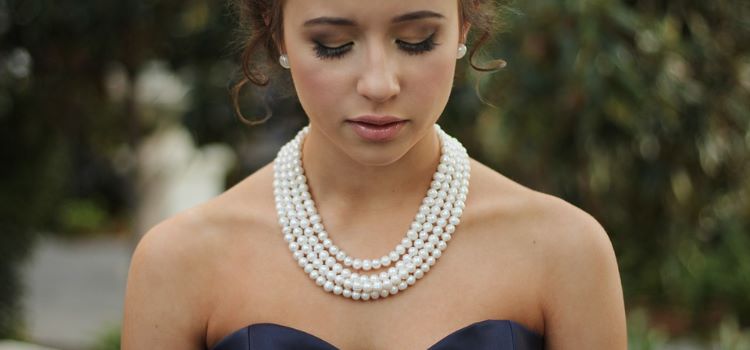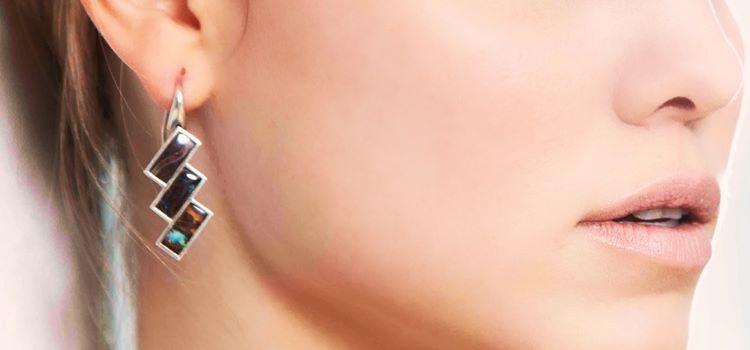Welcome to my gemstone guide, where I’ll be sharing valuable insights about precious stones. Are you curious to know what are the 7 precious stones? Look no further! In this article, I’ll provide you with a comprehensive gemstone list that includes the most coveted and sought-after gemstones in the world. From diamonds to pearls, these precious stones hold immense beauty and value.
As we delve into the world of gemstones, I’ll enlighten you on the unique characteristics and significance of each precious stone. Whether you’re a gemstone enthusiast, a jewelry lover, or simply want to expand your knowledge, this gemstone guide is here to assist you.
So, let’s embark on this journey together and discover the mesmerizing world of the 7 precious stones!
What Are Gemstones?
Gemstones are natural minerals that are prized for their beauty and used for ornamental purposes. They can include minerals, hardened organic substances like amber and pearl, and have high value due to their beauty, rarity, and other characteristics.
These natural minerals are formed deep within the Earth’s crust over millions of years. They are created through various geological processes, such as the cooling and crystallization of molten rock, the precipitation of minerals from water solutions, and the accumulation of organic materials in living organisms.
Gemstones come in a variety of colors, sizes, and shapes. They can be transparent, translucent, or opaque. Some gemstones, like diamonds and sapphires, are known for their hardness and durability, while others, like pearls, are formed by living organisms.
Gemstones have been used for centuries for their aesthetic appeal and symbolic meaning. They are often incorporated into jewelry, decorative objects, and even spiritual and healing practices. From ancient civilizations to modern societies, gemstones continue to captivate and adorn us with their natural beauty.
Types of Gemstones:
- Diamond: Valued for its brilliance and hardness, diamonds are one of the most sought-after gemstones.
- Ruby: Known for its vibrant red color, rubies are considered one of the most precious gemstones.
- Sapphire: With its stunning blue hue, sapphires are highly prized and associated with royalty and wisdom.
- Emerald: Admired for its lush green color, emeralds are often associated with rebirth and good fortune.
- Pearl: Unique among gemstones, pearls are formed by mollusks and cherished for their lustrous appearance.
- Oriental Cat’s Eye: A rare gemstone with a distinctive “cat’s eye” effect caused by its unique inclusions.
- Alexandrite: Known for its color-changing properties, alexandrite is a captivating and scarce gemstone.
Gemstones are not only beautiful and valuable, but they also hold cultural significance and personal meaning. Whether you admire them for their aesthetics or believe in their metaphysical properties, gemstones continue to be cherished and treasured by people around the world.
| Gemstone | Color | Hardness (Mohs scale) |
|---|---|---|
| Diamond | Colorless, various colors | 10 |
| Ruby | Red | 9 |
| Sapphire | Blue, various colors | 9 |
| Emerald | Green | 7.5 – 8 |
| Pearl | Various colors | 2.5 – 4.5 |
| Oriental Cat’s Eye | Honey brown, yellow-brown, green | 8.5 |
| Alexandrite | Color-changing: red to green | 8.5 |
Precious vs. Semi-Precious Stones
Gemstones are categorized as precious or semi-precious based on their perceived value. Although this distinction is not widely used by professional jewelers anymore, it is still commonly known among gemstone enthusiasts. The classification of a gemstone as precious or semi-precious was historically based on the stone’s presumed value.
Precious stones are considered to be of higher value and rarity compared to semi-precious stones. The four precious stones are diamond, ruby, emerald, and sapphire. These gemstones have been highly prized throughout history, and their demand has continued to increase over time.
Semi-precious stones, on the other hand, are gemstones that are still valuable but are generally more abundant and affordable compared to precious stones. Popular examples of semi-precious stones include opal, amber, amethyst, and aquamarine. These gemstones offer a wide range of colors and unique properties, making them popular choices for jewelry.
| Precious Stones | Semi-Precious Stones |
|---|---|
| Diamond | Opal |
| Ruby | Amber |
| Emerald | Amethyst |
| Sapphire | Aquamarine |
While the distinction between precious and semi-precious stones may not hold as much importance in the jewelry industry today, it continues to be a part of the gemstone classification system. Ultimately, the value and beauty of a gemstone are subjective and can vary depending on personal preferences and market trends.
Diamond
Diamonds are one of the most renowned and sought-after precious gemstones. Known for their exceptional beauty and durability, diamonds have become a symbol of everlasting love and commitment. They are widely used as the centerpiece for engagement rings, representing the eternal bond between two individuals.
What sets diamonds apart from other gemstones is their exceptional hardness. Diamonds are the hardest natural material on Earth, scoring a perfect 10 on the Mohs scale of mineral hardness. This hardness, combined with their brilliance and fire, makes diamonds a top choice for jewelry.
Diamonds come in various shapes, sizes, and colors. The colorless or near-colorless diamonds are the most valuable and prized for their purity. However, diamonds also exist in fancy colors, including yellow, blue, pink, and green, which are highly sought after by collectors and enthusiasts.
When buying a diamond, it is essential to consider the Four Cs – cut, color, clarity, and carat weight. The cut determines the diamond’s proportions and how well it reflects light, while color refers to the presence of any yellow or brown tones. Clarity measures the presence of inclusions or blemishes, and carat weight determines the size of the diamond.
| Color Scale | Clarity Scale |
|---|---|
| D (Colorless) | FL (Flawless) |
| E (Colorless) | IF (Internally Flawless) |
| F (Colorless) | VVS1, VVS2 (Very, Very Slightly Included) |
| G-H (Near Colorless) | VS1, VS2 (Very Slightly Included) |
| I-J (Near Colorless) | SI1, SI2 (Slightly Included) |
| K-M (Faint Yellow) | I1, I2, I3 (Included) |
Investing in a diamond requires careful consideration and expert guidance. Consulting with a reputable jeweler or gemologist can help ensure that you are getting a high-quality diamond that meets your desired specifications and budget.
Ruby: The Gem of Passion and Beauty
The ruby is a precious gemstone known for its mesmerizing red color and timeless elegance. This vibrant gem has captivated hearts and minds throughout history, symbolizing love, passion, and power. Rubies belong to the corundum mineral family and are renowned for their remarkable hardness, second only to diamonds. Let’s delve into the fascinating world of rubies and explore their unique characteristics that make them truly extraordinary.
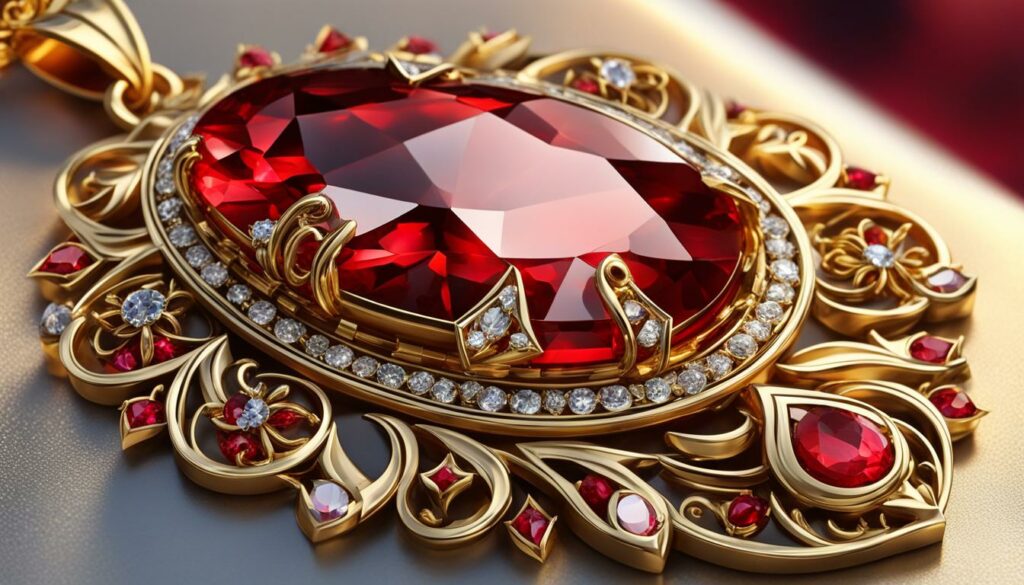
Mesmerizing Red: The Color of Desire
Rubies are treasured for their captivating red color, which ranges from deep red-purple to intense red-orange hues. The most coveted rubies exhibit a shade called “Pigeon Blood,” characterized by a rich, pure red color with a hint of blue undertones. This mesmerizing color is highly sought after and adds to the allure and value of rubies.
Fluorescence: Unveiling a Radiant Glow
One of the unique properties of rubies is their fluorescence. When exposed to ultraviolet light, a phenomenon known as fluorescence occurs, causing the ruby to emit a vibrant red glow. This natural fluorescence enhances the beauty of the gemstone, making it appear even more radiant and captivating.
A Gem of Rarity and Prestige
Rubies are considered one of the rarest gemstones, and their scarcity adds to their desirability and value. The finest rubies are found in Burma (Myanmar), where they are meticulously mined and carefully selected for their exceptional quality. These exquisite gemstones are a testament to nature’s artistry and hold a special place in the world of fine jewelry.
| Properties | Details |
|---|---|
| Mineral Family: | Corundum |
| Color: | Red, ranging from red-purple to red-orange |
| Hardness: | 9 on the Mohs scale |
| Fluorescence: | Exhibits a vibrant red glow under ultraviolet light |
| Origin: | Primarily Burma (Myanmar), as well as Thailand, Sri Lanka, and other regions |
Sapphires: The Alluring Blue Gemstones
When it comes to gemstones, sapphires are revered for their captivating beauty and striking colors. These precious stones, made of corundum, are most commonly associated with their deep and mesmerizing blue hue. However, sapphires are not limited to just blue; they are available in a wide range of colors, from vibrant pinks and yellows to subtle greens and purples. These non-blue variations are known as fancy sapphires and offer even more diversity to the world of gemstones.
The allure of sapphires lies not only in their color but also in their durability. Corundum, the mineral from which sapphires are formed, ranks 9 on the Mohs scale of mineral hardness, making it one of the toughest gemstones available. This durability ensures that sapphires can withstand everyday wear and tear, making them an excellent choice for jewelry that will last a lifetime.
When it comes to purchasing sapphires, there are certain factors to consider. The color of the stone is of utmost importance, with the most valuable sapphires exhibiting a rich and even hue. Clarity, cut, and carat weight are also essential aspects to evaluate when assessing the quality and value of a sapphire. Whether you’re looking for a classic blue sapphire or a unique fancy sapphire, these gemstones are sure to add a touch of elegance and sophistication to any jewelry collection.
Emerald: The Green Beauty of the Beryl Family
Emeralds are highly valued gemstones known for their beautiful green color. As a member of the beryl family, emeralds possess unique characteristics that make them truly special. The vivid green hue of emeralds is a result of impurities, including iron, vanadium, and chromium, in their chemical composition. These elements combine to create a stunning display of color that has captivated jewelry enthusiasts for centuries.
In addition to their striking appearance, emeralds have been associated with healing powers. Throughout history, these gemstones have been believed to promote physical, emotional, and spiritual well-being. Some cultures even thought that emeralds could enhance fertility, intelligence, and intuition. Whether you wear an emerald for its aesthetic appeal or for its perceived metaphysical properties, there’s no denying the allure of this remarkable gemstone.
Emeralds are a symbol of rebirth and renewal, capturing the essence of nature’s vibrant energy in their verdant depths.
To fully appreciate the beauty of emeralds, let’s examine their key characteristics in the table below:
| Characteristic | Description |
|---|---|
| Color | Rich green, ranging from light to dark shades |
| Hardness | 7.5-8 on the Mohs scale |
| Chemical Composition | Beryl (beryllium aluminum silicate) with trace elements |
| Transparency | Translucent to opaque |
| Origin | Colombia, Zambia, Brazil, and other locations |
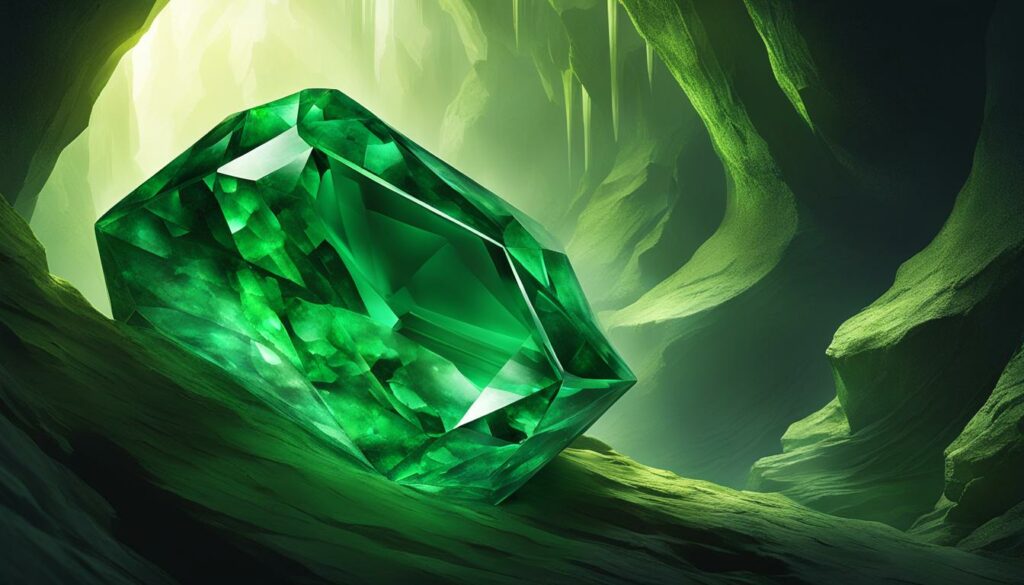
Emeralds continue to enchant gemstone lovers with their vibrant green color and captivating allure. Whether set in a ring, pendant, or earrings, these gemstones are sure to make a statement and add a touch of natural elegance to any jewelry collection.
Discover the Power of Emerald
Emeralds are said to bestow a range of healing and metaphysical properties upon their wearers. Here are some of the purported benefits associated with emeralds:
- Enhances emotional well-being and promotes harmony
- Encourages growth, abundance, and prosperity
- Aids in spiritual development and opens the heart chakra
- Supports healing and balances the body’s energy
Whether you’re drawn to emeralds for their captivating beauty or their metaphysical properties, these gemstones are a stunning choice for anyone looking to make a statement with their jewelry.
Pearl
When it comes to gemstones, pearls are truly unique. Unlike other gemstones, pearls are not mineral-based. Instead, they are formed when irritants like sand find their way inside mollusks. The mollusk then secretes layers of nacre, a substance made of calcium carbonate, around the irritant, creating a pearl. This organic substance gives pearls their lustrous and iridescent appearance.
There are several types of pearls, each with its own distinct characteristics. Freshwater pearls are cultivated in freshwater bodies such as lakes and rivers. They are known for their varied shapes, sizes, and colors, making them a versatile choice for jewelry. Akoya pearls, on the other hand, are saltwater pearls that are cherished for their high levels of luster and round shape. Tahitian pearls, often referred to as black pearls, come from French Polynesia and are prized for their natural dark colors, including shades of black, green, and gray. South Sea pearls are cultivated in the warm waters of the South Pacific and are renowned for their larger size and exquisite luster.
Pearls hold a special place in the world of gemstones, as they are the birthstone for the month of June. Symbolizing purity and innocence, pearls are often associated with elegance and sophistication. Whether it’s a classic strand of pearls or a contemporary piece of pearl jewelry, these organic gemstones never fail to captivate with their timeless beauty.
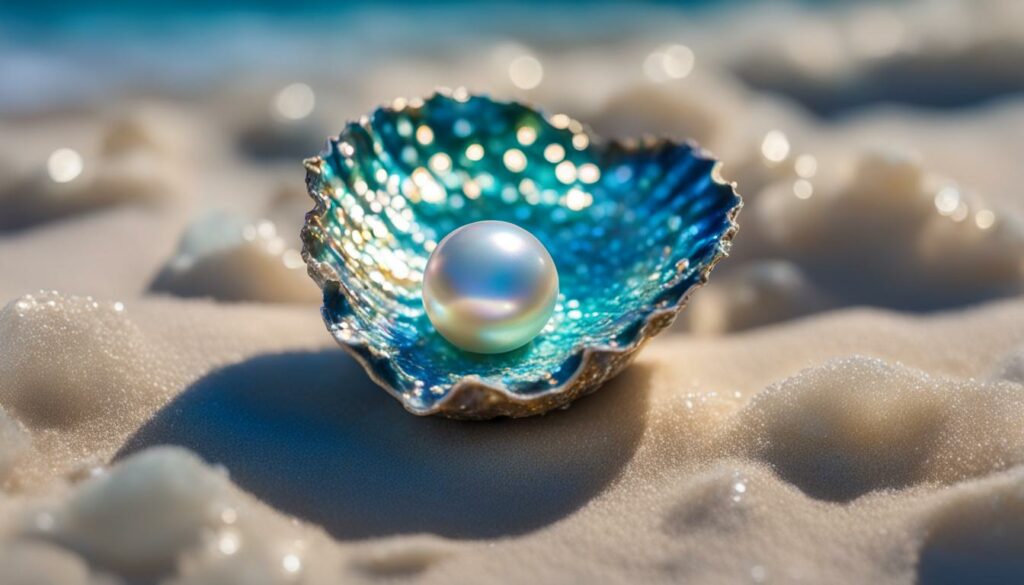
| Type of Pearl | Origin | Characteristics |
|---|---|---|
| Freshwater Pearls | Lakes and Rivers | Variety of shapes, sizes, and colors |
| Akoya Pearls | Saltwater | High luster, round shape |
| Tahitian Pearls | French Polynesia | Dark colors (black, green, gray) |
| South Sea Pearls | South Pacific | Larger size, exquisite luster |
Oriental Cat’s Eye: A Rare Gemstone with a Striking Shadow Effect

The Oriental cat’s eye, also known as the chatoyant chrysoberyl, is a fascinating and rare gemstone that captures attention with its unique shadow effect. This gemstone belongs to the chrysoberyl family and displays a captivating play of light that resembles a cat’s eye. The remarkable shadow effect is caused by fine silk inclusions within the stone, which interact with light to create a distinct optical phenomenon.
Oriental cat’s eye gemstones come in colors ranging from honey brown and yellow-brown to green. When light hits the surface of the stone, it forms a narrow band of light that seems to glide across the gemstone, resembling the slit-shaped pupil of a cat’s eye. This mesmerizing effect adds depth and intrigue to the stone, making it highly sought after by collectors and gemstone enthusiasts.
Due to its rarity and unique optical properties, the Oriental cat’s eye is considered a prized gemstone. Its scarcity contributes to its value, making it an exclusive addition to any gemstone collection. Whether admired for its natural beauty or appreciated for its symbolic significance, the Oriental cat’s eye continues to captivate and fascinate gemstone connoisseurs around the world.
Alexandrite: The Enigmatic Color-Changing Gemstone of Rarity and Luxury
Alexandrite is a truly remarkable gemstone known for its mesmerizing color-changing abilities. This rare and highly coveted stone can transform from a striking ruby red in incandescent light to a vibrant emerald green in daylight. The captivating play of colors in alexandrite is a result of its unique chemical composition and light absorption properties.
The scarcity of alexandrite contributes to its exclusivity and high price tag. This gemstone is rarely found in large sizes, making it even more valuable to collectors and enthusiasts. Its scarcity, combined with its enchanting color-changing properties, places alexandrite among the most expensive gemstones in the world.
Due to its rarity and beauty, alexandrite has become a popular choice for those seeking a unique and exquisite gemstone. Its color-changing nature makes it a captivating centerpiece for jewelry pieces, adding an element of intrigue and sophistication.
| Alexandrite | |
|---|---|
| Color | Ruby red (incandescent light) to emerald green (daylight) |
| Rarity | Highly rare |
| Price | Among the most expensive gemstones |
| Value Factors | Color-changing ability, size, clarity |
| Associated Characteristics | Exclusivity, luxury, rarity |
The allure of alexandrite lies in its ability to captivate with its ever-changing hues. Its scarcity and association with luxury make it a highly sought-after gemstone for collectors and connoisseurs alike.
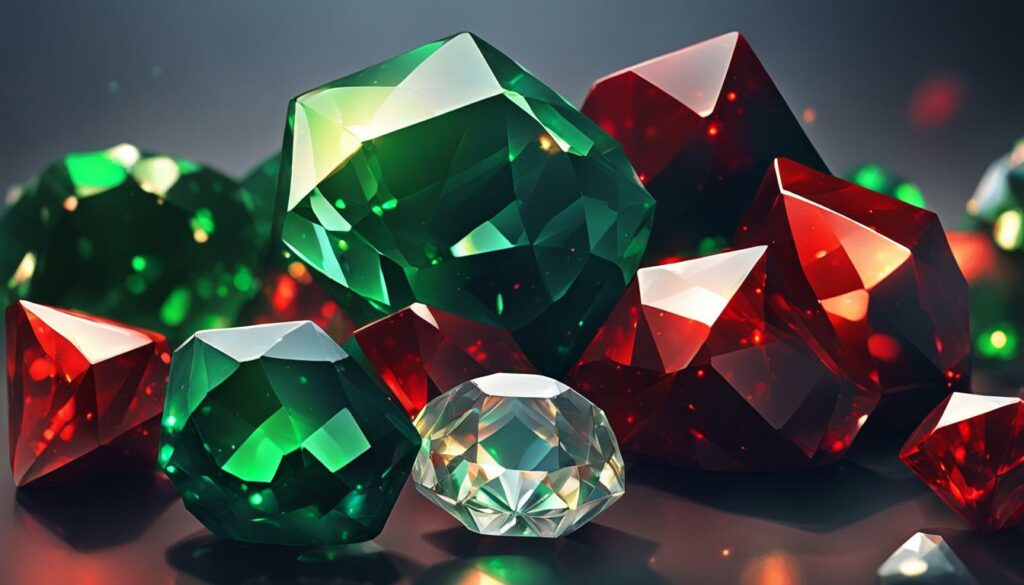
What are Semi Precious Stones?
Semi-precious stones are a captivating category of gemstones that possess their own unique beauty, value, and charm. While the distinction between precious and semi-precious stones is not as widely used in the jewelry industry today, these gems continue to enchant enthusiasts and collectors alike. Unlike their precious counterparts, semi-precious stones offer a more affordable option for those seeking to adorn themselves with exquisite gemstones.
What sets semi-precious stones apart is their varied composition and striking range of colors, making them perfect for creating eye-catching jewelry pieces. From the enchanting opalescence of opals to the mesmerizing hues of amethysts and aquamarines, each semi-precious stone showcases its own unique character and allure.
Although they may be called “semi-precious,” it’s important to note that these gemstones can still carry significant value and rarity. Their accessibility and affordability provide an opportunity for anyone to enjoy the magic of gemstones and express their own personal style.
| Semi-Precious Stones | Hues and Colors | Properties |
|---|---|---|
| Opal | White, Blue, Green, Brown, Black | Iridescent, Play of Colors |
| Amber | Yellow, Orange, Brown | Natural Resin, Warmth |
| Amethyst | Purple | Calming, Spiritual |
| Aquamarine | Light Blue | Refreshing, Serene |
“Semi-precious stones may be called ‘semi,’ but their allure and value are anything but. These gemstones offer a world of captivating colors and unique properties that make them highly desirable in their own right.” – Gemstone Expert
Gem Classification: Precious Stones vs. Semi Precious Stones
When it comes to gemstones, they can be classified into two categories: precious stones and semi-precious stones. This classification is based on the perceived value of the gemstones.
Precious stones are highly valued and often considered the most valuable gemstones. The four precious stones are diamond, ruby, emerald, and sapphire. These gemstones are known for their rarity, beauty, and historical significance. They have been sought after for centuries and continue to be highly coveted by collectors and jewelry enthusiasts alike.
Semi-precious stones, on the other hand, may not have the same level of value as precious stones, but they are still prized for their beauty and unique characteristics. Examples of popular semi-precious stones include opal, amber, amethyst, and aquamarine. While the distinction between precious and semi-precious stones is not as widely used in the gemstone industry today, these terms remain in common vocabulary.
| Precious Stones | Semi-Precious Stones |
|---|---|
| Diamond | Opal |
| Ruby | Amber |
| Emerald | Amethyst |
| Sapphire | Aquamarine |
Whether a gemstone is classified as precious or semi-precious, each stone carries its own unique beauty and allure. The value of a gemstone is not solely determined by its classification, but rather by a combination of factors such as clarity, rarity, carat weight, color, and cut.
Diamonds and Colored Stones
When it comes to the world of gemstones, diamonds and colored stones play a significant role. Diamonds, the best-selling gemstone, hold about 80% of the gemstone sales revenue, making them a powerhouse in the industry. Known for their unparalleled clarity and brilliance, diamonds are highly sought after for engagement rings and other fine jewelry pieces. The mining of diamonds involves intricate processes, including exploration, extraction, and processing, to ensure the highest quality gems reach the market.
Colored stones, on the other hand, offer a dazzling array of vibrant hues and unique characteristics. From the mesmerizing greens of emeralds to the fiery reds of rubies, colored stones add a captivating touch to any jewelry collection. Gem cutting plays a crucial role in bringing out the brilliance and beauty of colored stones. Skilled lapidaries use precision techniques to enhance the color, clarity, and overall appearance of each gem.
Gemstone mining is another essential aspect of the industry. It involves extracting gem-bearing rocks from the earth and carefully processing them to uncover the hidden treasures within. Mining techniques vary depending on the type of gemstone being sought. This process requires expertise and a deep understanding of geology, as well as sustainable practices to minimize the impact on the environment.
| Gemstone | Description |
|---|---|
| Diamond | The hardest known natural material, known for its exceptional brilliance. |
| Ruby | A stunning red gemstone prized for its vibrant color and historical significance. |
| Emerald | A lush green gemstone associated with beauty, harmony, and spiritual growth. |
| Sapphire | A gemstone known for its brilliant blue hues, but can also be found in various other colors. |
| Pearl | An organic gem formed inside mollusks, symbolizing purity and elegance. |
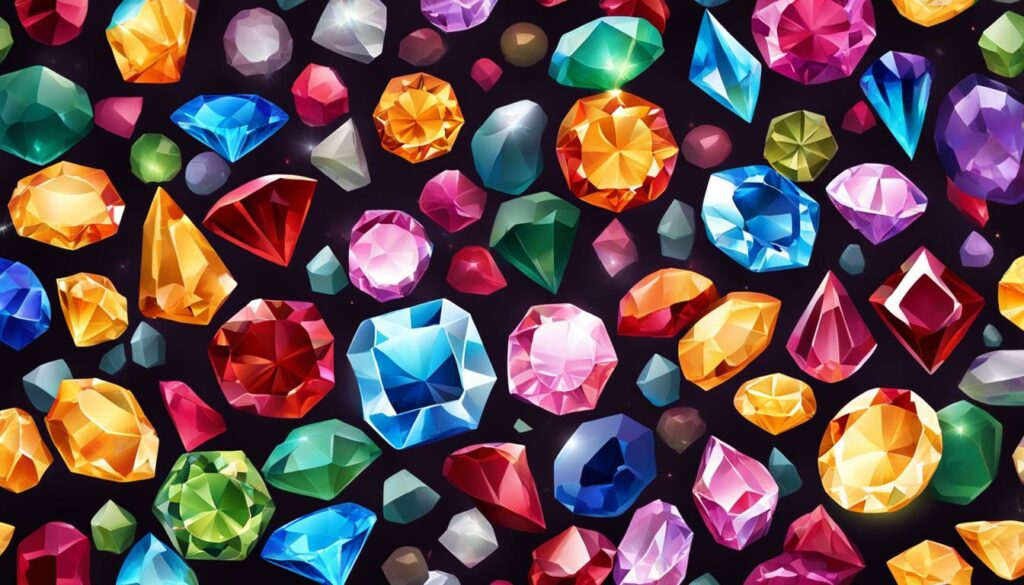
As you delve into the world of gemstones, exploring both diamonds and colored stones will unveil a realm of beauty and fascination. Whether it’s the flawless clarity of a diamond or the mesmerizing play of colors in a sapphire, each gemstone holds its own unique allure. Understanding the processes behind gem cutting and mining provides a deeper appreciation for the craftsmanship and artistry involved in the creation of these natural treasures.
How to Determine the Value of Your Precious Stone or Semi Precious Gemstones
When it comes to assessing the value of precious stones or semi-precious gemstones, several factors come into play. These factors include clarity, rarity, carat weight, color, and cut. Each of these elements contributes to the overall value of a gemstone and can greatly impact its desirability and market price.
Clarity: The clarity of a gemstone refers to the presence of any internal or external flaws, known as inclusions. Gemstones with fewer inclusions are considered to have higher clarity and are therefore more valuable. Inclusions can affect the stone’s transparency and brilliance.
Rarity: Rarity is a significant factor in determining the value of a gemstone. Gemstones that are rare or difficult to find are typically more valuable. Certain colors or variations within a specific gemstone type can also contribute to its rarity and subsequent value.
“The value of a gemstone depends on its clarity, rarity, carat weight, color, and cut.”
Carat Weight: Carat weight refers to the size or mass of a gemstone. Generally, larger gemstones are more valuable than smaller ones. However, other factors such as quality and rarity can outweigh the importance of carat weight in determining a gemstone’s value.
Color: The color of a gemstone greatly influences its value. Stones with vivid and vibrant colors are typically more desirable and command higher prices. The intensity, hue, and uniformity of the color play a crucial role in determining a gemstone’s value.
Cut: The cut of a gemstone refers to its shape and the quality of the angles and facets. A well-cut gemstone reflects light in a way that enhances its beauty and brilliance, increasing its value. Precise and symmetrical cuts are highly valued in the gemstone market.
Understanding these factors and how they contribute to the value of a gemstone can help you make informed decisions when buying or selling precious stones or semi-precious gemstones.
| Factor | Description |
|---|---|
| Clarity | The presence of flaws or inclusions in the gemstone. |
| Rarity | The scarcity or uniqueness of the gemstone. |
| Carat Weight | The size or mass of the gemstone. |
| Color | The hue, intensity, and uniformity of the gemstone’s color. |
| Cut | The shape, angles, and facets of the gemstone. |
Considering these factors and seeking professional gem appraisals can help you determine the true value of your precious stone or semi-precious gemstone. Whether you’re looking to sell, buy, or simply understand the worth of your gemstone, consulting with experts in the field will ensure you receive accurate assessments and information.
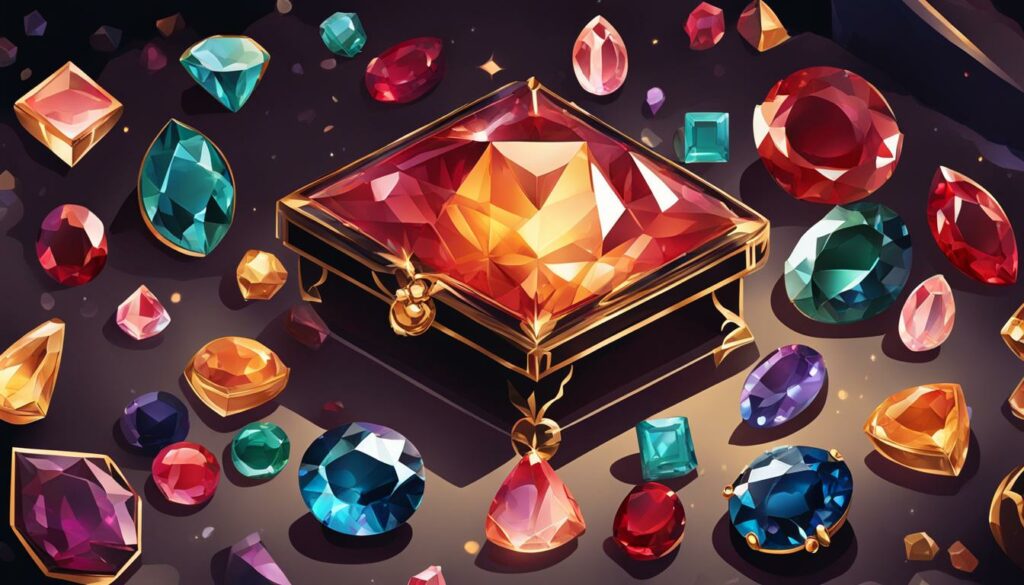
Get an Honest and Professional Gem Appraisal in Chicago
If you’re looking for a reliable and accurate gem appraisal in the Chicago area, you’ve come to the right place. I offer expert assessment services to help you determine the true value of your precious stones and semi-precious gemstones.
With years of experience in the industry, I understand the importance of providing an honest and thorough evaluation. I take into account various factors that contribute to a gemstone’s value, including its clarity, rarity, carat weight, color, and cut. By carefully examining these aspects, I can provide you with a reliable assessment that reflects the true worth of your gemstones.
Whether you’re looking to sell your gemstones, insure them, or simply want to have a better understanding of their value, my professional appraisal services can give you the information you need. I pride myself on delivering accurate and unbiased evaluations, ensuring that you receive the most reliable assessment possible.
Don’t leave the value of your precious stones and semi-precious gemstones to guesswork. Contact me today for an honest and professional gem appraisal in Chicago.
Conclusion
In conclusion, this gemstone guide has provided valuable insights into the world of precious stones. The seven precious stones – diamond, ruby, emerald, sapphire, pearl, Oriental cat’s eye, and alexandrite – hold a special place in the realm of gemstones, with their beauty, rarity, and value.
Understanding the characteristics and significance of these gemstones is crucial for anyone interested in owning or purchasing them. From the timeless elegance of diamonds to the vibrant allure of rubies, each stone has its unique charm and appeal.
Whether you’re looking for an engagement ring, a birthstone gift, or simply a stunning piece of jewelry, the knowledge gained from this guide will help you make informed choices. Remember to consider factors such as clarity, rarity, carat weight, color, and cut when assessing the value of your gemstones.
With this comprehensive gemstone guide featuring the 7 precious stones, you can confidently navigate the world of gemstones and appreciate their enduring beauty.
FAQ
What are the 7 precious stones?
The 7 precious stones are diamond, ruby, emerald, sapphire, pearl, Oriental cat’s eye, and alexandrite.
What are gemstones?
Gemstones are natural minerals used for ornamental purposes, prized for their beauty and rarity.
What is the difference between precious and semi-precious stones?
Precious stones include diamond, ruby, emerald, and sapphire, while semi-precious stones include opal, amber, amethyst, and aquamarine.
What makes diamonds special?
Diamonds are the hardest material, often used in engagement rings, and associated with eternal love and purity.
What are the characteristics of rubies?
Rubies are highly valued for their rich red color, hardness, and the most valuable ones have a shade called “Pigeon Blood.”
What are sapphires known for?
Sapphires are known for their durability, striking blue color, and are available in various colors known as fancy sapphires.
What makes emeralds valuable?
Emeralds are highly valuable for their beautiful green color and are believed to have healing and mystical powers.
How are pearls formed?
Pearls are formed when irritants like sand enter mollusks and layers of nacre form around them. They come in different types like freshwater, Akoya, Tahitian, and South Sea pearls.
What is Oriental Cat’s Eye?
Oriental cat’s eye, also known as cymophane, is a rare gemstone with a shadow effect resembling a cat’s eye caused by fine silk inclusions.
What is special about alexandrite?
Alexandrite is a rare gemstone known for its color-changing abilities, ranging from ruby red to emerald green in different lighting conditions.
How are gemstones classified?
Gemstones are classified as precious or semi-precious based on their perceived value.
What is the difference between precious stones and semi-precious stones?
Precious stones include diamond, ruby, emerald, and sapphire, while semi-precious stones include opal, amber, amethyst, and aquamarine.
What are the best-selling gemstones?
Diamonds are the best-selling gemstone, followed by colored stones including precious and semi-precious stones.
How do you determine the value of a gemstone?
The value of a gemstone depends on factors like clarity, rarity, carat weight, color, and cut. Gem appraisals can help determine their value.
Where can I get a reliable gem appraisal in Chicago?
Seek out trusted experts in Chicago who can provide an honest assessment of your gemstones’ value.
Source Links
- https://clarkpawners.com/what-are-the-7-precious-stones/
- https://lackorecouture.com/blogs/guides/precious-stones
- https://www.gemsociety.org/gemstone-encyclopedia/

Hey lovely readers! My name is Chantal and I am obsessed with everything accessory and jewelry. My husband (and best friend) John and I, have been writing content for this blog for over 4 years now started the RTP store with over 4000 curated accessories and jewelry. We are traveling around the world to find the latest products, negotiate the best prices and find the best quality for our readers. We have managed to make our passion for feeling and looking good into our work. We are always open to new product suggestion, improvements or feedback. If you would like to chitchat with me, email me here!


